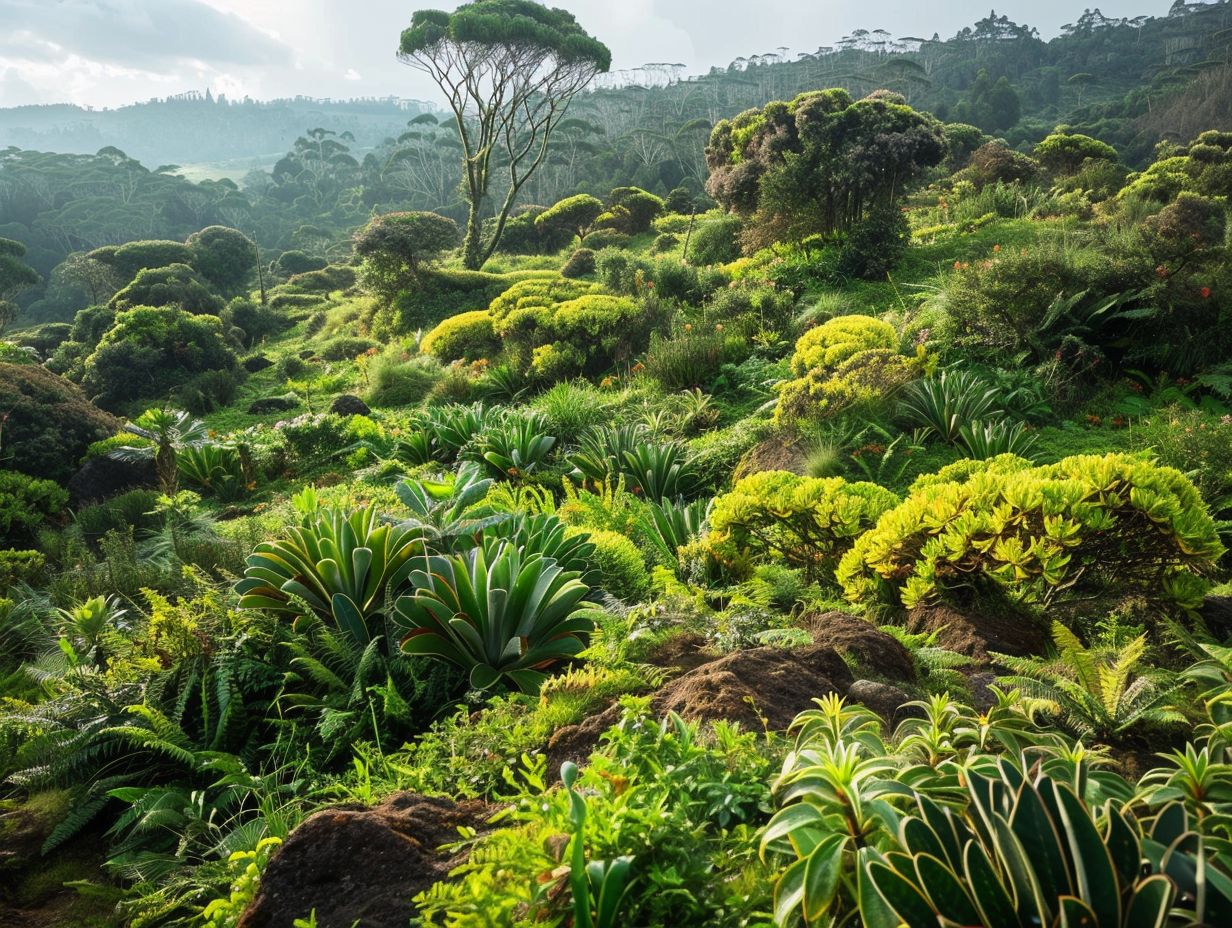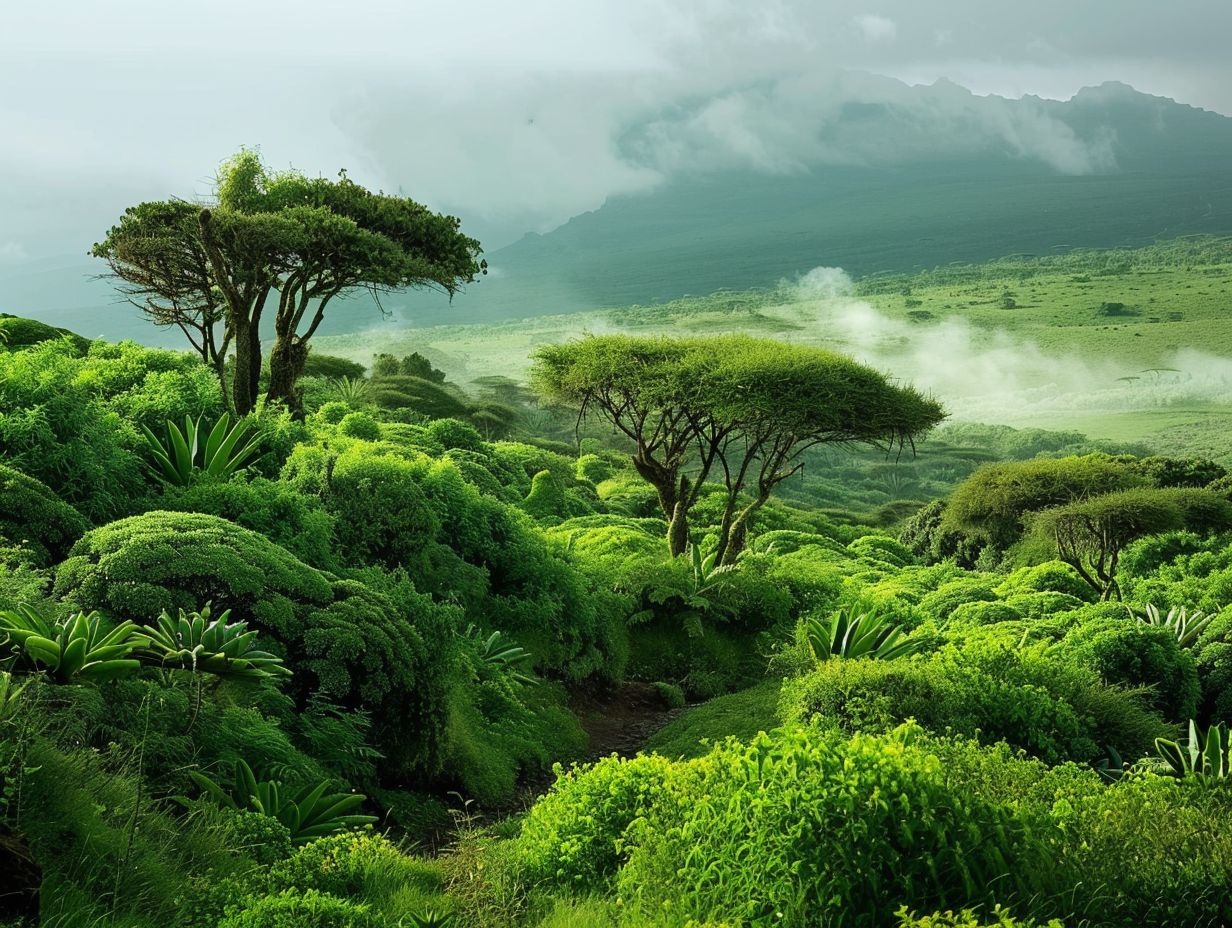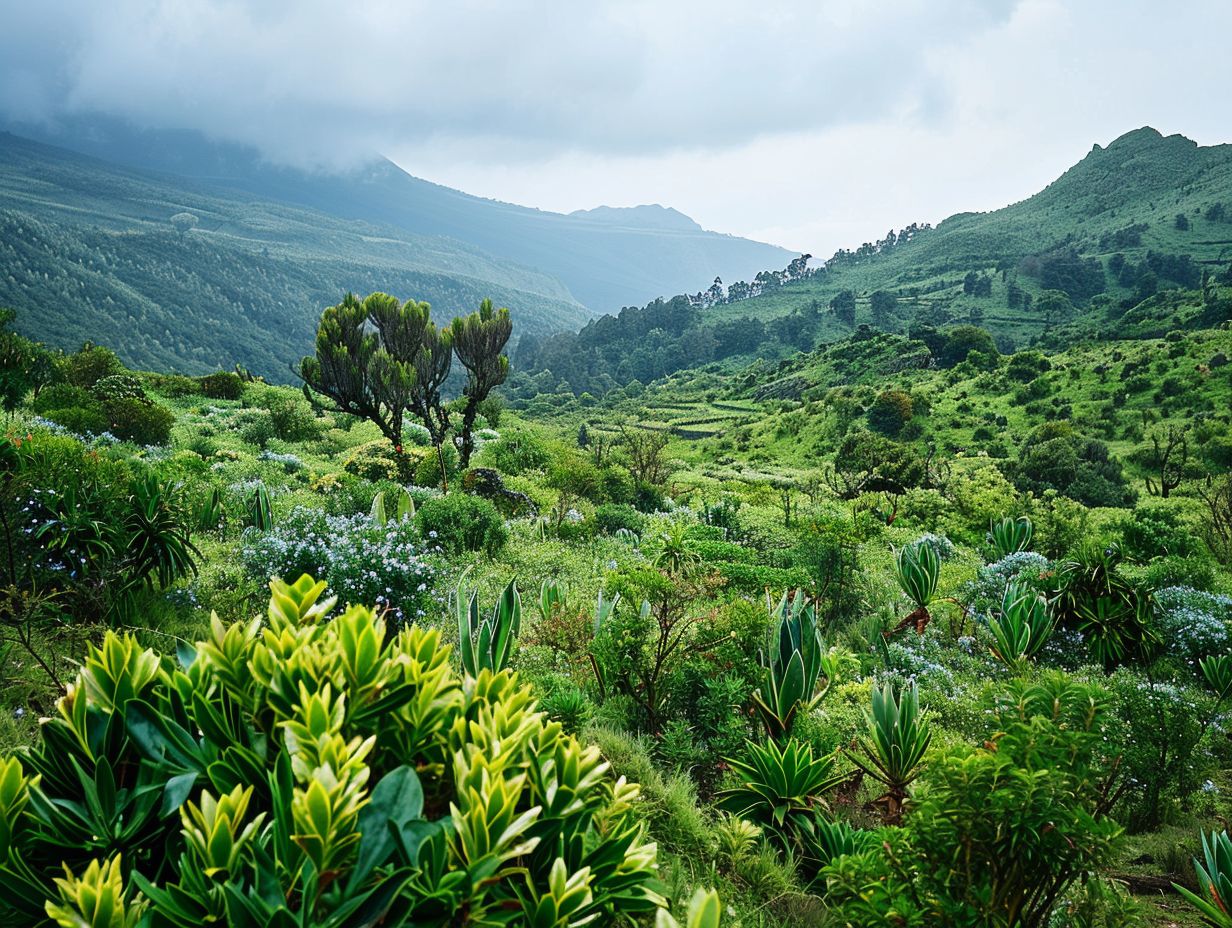
Kilimanjaro Plant Life
Kilimanjaro, the iconic African mountain, is not only known for its breathtaking views and challenging climbs but also for its diverse plant life.
We will explore the climate of Kilimanjaro and the different climatic zones that exist on the mountain.
Delve into the factors that affect plant life, such as altitude, temperature, precipitation, and soil quality.
Discuss the various types of plant life found on Kilimanjaro, from alpine plants to cultivated species.
Examine the impact of human activity on plant life, including threats and conservation efforts in place.
Join us on this journey to discover the fascinating world of plant life on Kilimanjaro.
Key Takeaways:

- The climate of Kilimanjaro is diverse, with various climatic zones that greatly affect plant life.
- Altitude, temperature, precipitation, and soil quality are key factors that shape the types of plant life found on Kilimanjaro.
- Human activities pose a threat to plant life on Kilimanjaro, making conservation efforts crucial for the preservation of its unique and diverse plant life.
What is the Climate of Kilimanjaro?
Mount Kilimanjaro in East Africa has a diverse climate due to its varying altitudes, ranging from tropical conditions at the base to arctic conditions at the summit, Kilimanjaro.
As one ascends the mountain, the temperature plummets due to the altitude. For every 1000 meters increase in elevation, the temperature drops by about 6.5°C. This significant drop results in the summit being covered in snow and experiencing freezing temperatures year-round. The altitude also plays a crucial role in the precipitation levels, with the lower slopes receiving more rainfall compared to the barren, dry upper reaches.
The unique ecosystem that thrives on Kilimanjaro is known as an Afro-alpine zone, showcasing a variety of endemic plant and animal species. At higher altitudes, vegetation becomes sparse, giving way to unique flora adapted to the harsh conditions, such as giant lobelias and groundsels. This delicate ecosystem exemplifies nature’s resilience and ability to adapt to extreme environments.
What are the Different Climatic Zones on Kilimanjaro?
The different climatic zones on Mount Kilimanjaro include the tropical rainforest zone, the alpine desert zone, and the arctic zone, each characterized by distinct flora and fauna adaptations.
Starting from the lower altitudes of Mount Kilimanjaro, the tropical rainforest zone is known for its lush vegetation, with towering trees and diverse wildlife such as monkeys and colorful birds. The temperatures range from around 70°F to 80°F in this zone, providing a warm and humid environment.
Moving higher up, the alpine desert zone features sparse vegetation adapted to the harsh conditions, with temperatures dropping to around freezing point at night. In the arctic zone, only mosses and lichens can survive the extreme cold, with temperatures plummeting well below freezing.
What are the Factors that Affect Plant Life on Kilimanjaro?
The plant life on Kilimanjaro is influenced by various factors such as altitude, temperature variations, precipitation levels, and soil quality, creating different vegetation zones along the mountain.
At lower altitudes, you will find lush rainforests with abundant species diversity, thriving in the warmer temperatures and higher precipitation levels. Moving up the mountain, the vegetation transitions to montane forests characterized by mosses and ferns, adapting to cooler temperatures and reduced rainfall.
Vegetation zones change as one ascends, with heath and moorland dominating the midsection, displaying hardier plant species equipped to endure colder conditions and thinner soils. Heading towards the summit, the alpine desert region showcases resilient alpine plants that have evolved to survive in harsh, arid environments with extreme temperature fluctuations.
-
How Does Altitude Affect Plant Life on Kilimanjaro?
Altitude plays a crucial role in shaping the plant life on Kilimanjaro, with distinct vegetation zones emerging at different elevations, from lush forests at lower altitudes to sparse alpine plants at higher elevations.
As one ascends Mount Kilimanjaro, the air becomes thinner, resulting in reduced oxygen levels and cooler temperatures. These harsh conditions at higher altitudes require plants to develop unique adaptations to survive. For example, alpine plants may have small leaves or reduced surface area to minimize water loss due to the drier air. Some plants on Kilimanjaro have evolved mechanisms to efficiently absorb nutrients from the rocky, nutrient-poor soils found at higher elevations.
-
How Does Temperature Affect Plant Life on Kilimanjaro?

Temperature variations on Kilimanjaro impact the distribution of plant species, with cold-adapted plants thriving in the higher elevations while heat-tolerant species dominate the lower slopes.
These temperature gradients create distinct ecological zones along the mountain, each characterized by specific assemblages of plant life. At higher altitudes where temperatures are cooler, plants have evolved unique adaptations to survive in harsh conditions, such as compact growth forms and hairy leaves to minimize heat loss.
Conversely, lower slopes experience warmer temperatures, leading to a different array of plant species that can withstand heat stress. Some plants on Kilimanjaro exhibit a remarkable ability to adjust their metabolism in response to temperature fluctuations, allowing them to thrive in diverse climatic conditions.
-
How Does Precipitation Affect Plant Life on Kilimanjaro?
Precipitation patterns on Kilimanjaro significantly impact the distribution of plant species, with moisture-loving plants thriving in wetter regions and drought-resistant flora prevailing in drier areas.
This diverse ecosystem showcases an intriguing interplay between rainfall levels and plant adaptations. In the lush, rainy zones of the mountain, towering trees like African yellowwoods and giant senecios dominate the landscape, benefitting from the abundant moisture.
On the other hand, the arid, rain-shadow regions host resilient species such as the famous Kilimanjaro tree groundsels, displaying remarkable tolerance to water scarcity.
The differing precipitation amounts create microhabitats that offer niche opportunities for unique plant communities to flourish. As rainfall levels shift with altitude and changing weather patterns, certain endemic species have evolved specialized mechanisms to survive in these dynamic environments.
-
How Does Soil Quality Affect Plant Life on Kilimanjaro?
Soil quality is a critical factor influencing plant distribution on Kilimanjaro, with nutrient-rich soils supporting diverse vegetation while nutrient-poor soils restrict plant growth in certain regions of the mountain.
The composition of soil, in terms of its nutrient content and pH levels, plays a pivotal role in determining which plant species thrive in specific areas of Kilimanjaro.
Soil nutrients, such as nitrogen, phosphorus, and potassium, are essential for plant growth and productivity. Areas with fertile soils tend to harbor a wide range of plant species, contributing to the overall biodiversity on the mountain. Conversely, regions with nutrient-poor soils may exhibit sparse vegetation as plants struggle to establish and compete for limited resources.
What are the Types of Plant Life on Kilimanjaro?
The plant life on Kilimanjaro encompasses a wide range of species, from endemic Giant Groundsels and Lobelia Deckenii to unique flora such as Helichrysum Newi and Protea Kilimandscharica, reflecting the mountain’s rich botanical diversity.
These plant species have evolved to thrive in the varying climatic conditions across Kilimanjaro’s distinct vegetation zones, including rainforests, heath, and alpine desert. One of the most fascinating aspects of Kilimanjaro’s flora is the endemicity, with many species found only on this majestic mountain.
The vegetation changes dramatically as you ascend, transitioning from lush forested slopes teeming with life to the surreal alpine desert where plants cling to rocky outcrops. Each zone showcases unique adaptations of plants to survive in the harsh mountain environment.
-
What are the Characteristics of Alpine Plants on Kilimanjaro?
Alpine plants on Kilimanjaro exhibit adaptations to cold, high-altitude environments, with features like reduced leaf size, dense growth habits, and specialized structures that enable them to survive in harsh conditions.
One of the remarkable traits of these alpine plants is their ability to withstand freezing temperatures by developing trichomes on their leaves, which act as insulation against the cold.
These trichomes not only provide protection from frost but also minimize water loss through transpiration, crucial for survival in a dry, high-elevation setting. Many species possess deep taproots that extend far into the soil to access water reserves, a vital strategy for conquering the arid conditions prevalent in the alpine zone on Kilimanjaro.
-
What are the Characteristics of Montane Forest Plants on Kilimanjaro?

Montane forest plants on Kilimanjaro display lush foliage, tall trees, and diverse undergrowth, thriving in the moderate temperatures and high humidity of the montane forest zone.
These plants have evolved unique adaptations to flourish in such conditions. For example, many of them have broad leaves to capture ample sunlight for photosynthesis.
Epiphytic plants such as orchids and ferns are common, growing on tree branches to access light without relying on root systems in the dense forest floor soil. Some plants have developed shallow root systems to efficiently absorb nutrients from the moist soil. The biodiversity in these montane forests is astounding, with a plethora of plant species thriving in this specialized environment.
-
What are the Characteristics of Subalpine Plants on Kilimanjaro?
Subalpine plants on Kilimanjaro thrive in the transition zone between the forest and alpine regions, exhibiting adaptations to cooler temperatures and rocky terrains, with species like Red Hot Poker and Hebenstretia Dentata being prevalent.
These plants have evolved strategies to cope with the harsh conditions of their environment. They often have dense foliage and compact growth habits to minimize exposure to winds and conserve moisture.
In addition, many subalpine plants on Kilimanjaro develop deep root systems that allow them to access water sources deep within the rocky soils. Some species have specialized structures, such as hairy leaves or waxy coatings, which help reduce water loss due to the cooler temperatures and dry air prevalent in the subalpine zone.
-
What are the Characteristics of Cultivated Plants on Kilimanjaro?
Cultivated plants on Kilimanjaro include species introduced by humans for agriculture or ornamental purposes, with examples like Fireball Lily and Tussock found in cultivated areas near settlements on the mountain.
These human-introduced species play a crucial role in the agricultural and landscaping contexts of the region. They not only add aesthetic value but also contribute to the biodiversity and sustainability of the area. Fireball Lily, for instance, with its vibrant red flowers, symbolizes beauty and resilience against the harsh conditions of the mountain. Similarly, the Tussock grass provides vital groundcover, preventing soil erosion and supporting other plant life in the ecosystem.
How Does Human Activity Affect Plant Life on Kilimanjaro?
Human activity on Kilimanjaro poses threats to the plant life through deforestation, habitat destruction, and invasive species introduction, prompting conservation efforts to preserve the unique flora of the mountain.
Deforestation, primarily driven by agriculture expansion and logging activities, has resulted in the loss of crucial plant habitats on Kilimanjaro. This alteration in the ecosystem disrupts the delicate balance of flora and fauna, leading to a decline in biodiversity.
Invasive species, often introduced accidentally or intentionally, outcompete native plants, further jeopardizing the indigenous vegetation of the region. To counter these challenges, conservationists have established protected areas and reforestation projects to restore and protect the diverse plant species that call Kilimanjaro home.
-
What are the Threats to Plant Life on Kilimanjaro?
The plant life on Kilimanjaro faces threats from deforestation, climate change, agricultural expansion, and the spread of non-native species, endangering the unique vegetation and ecosystems of the mountain.
Deforestation on Kilimanjaro is a significant threat to plant life, leading to habitat destruction and soil erosion. As trees are cut down for timber or cleared for agriculture, the delicate balance of the mountain’s ecosystems is disrupted. Climate variations pose another challenge, with shifts in temperature and precipitation patterns affecting plant growth.
Human encroachment further exacerbates these issues, as settlements and infrastructure developments encroach on natural habitats. The introduction of non-native species also disrupts the native flora, outcompeting local plants and altering the biodiversity of the mountain.
-
What are the Conservation Efforts in Place for Plant Life on Kilimanjaro?

Conservation efforts on Kilimanjaro aim to protect the diverse plant species by establishing national parks, promoting sustainable land use practices, and raising awareness about the importance of preserving the mountain’s unique flora.
One key aspect of the conservation initiatives on Kilimanjaro is the effective park management system in place. This involves monitoring vegetation changes, enforcing regulations to prevent illegal logging and deforestation, and implementing measures to control invasive species that threaten the native plants.
Community involvement plays a vital role, with local residents participating in reforestation projects and sustainable agriculture practices to reduce pressure on the ecosystem. Education campaigns are also vital, educating visitors and local communities about the significance of biodiversity conservation and encouraging environmentally conscious behaviors.
Frequently Asked Questions:
1. What types of plant life can be found on Mount Kilimanjaro?
A: There is a wide variety of plant life on Mount Kilimanjaro, including lush rainforests, heath and moorland, alpine desert, and arctic tundra. Some examples of plant species include giant groundsels, lobelias, and evergreen trees such as the African yellowwood.
2. How do plants survive in the harsh conditions of Mount Kilimanjaro?
A: The unique plant life on Mount Kilimanjaro has adapted to survive in the extreme conditions of high altitude, low oxygen levels, and fluctuating temperatures. Many plants have developed specialized structures and functions, such as deep root systems and thick leaves, to thrive in these conditions.
3. Are there any rare or endangered plant species on Mount Kilimanjaro?
A: Yes, there are several rare and endangered plant species found on Mount Kilimanjaro, including the Kilimanjaro tree heath, Kilimanjaro white-starred bushbuck, and the Senecio kilimanjari. These plants are protected and monitored by conservation efforts to preserve their populations.
4. What is the significance of plant life on Mount Kilimanjaro?
A: The plant life on Mount Kilimanjaro plays a crucial role in supporting the mountain’s delicate ecosystem. Plants provide food and shelter for a variety of animals, help regulate the mountain’s climate, and prevent soil erosion. They also hold cultural and spiritual significance for the local people.
5. Can visitors explore and learn about the plant life on Mount Kilimanjaro?
A: Yes, visitors can explore and learn about the plant life on Mount Kilimanjaro through guided hikes or tours. There are also educational resources and exhibits available at the Kilimanjaro National Park Visitor Center. However, it is important to follow guidelines and regulations to protect the fragile plant life.
6. Does the plant life on Mount Kilimanjaro face any threats?
A: Unfortunately, the plant life on Mount Kilimanjaro is facing threats such as climate change, deforestation, and illegal harvesting. These factors can disrupt the delicate balance of the mountain’s ecosystem and endanger the survival of certain plant species. Sustainable conservation efforts are crucial for preserving the unique plant life on Kilimanjaro.